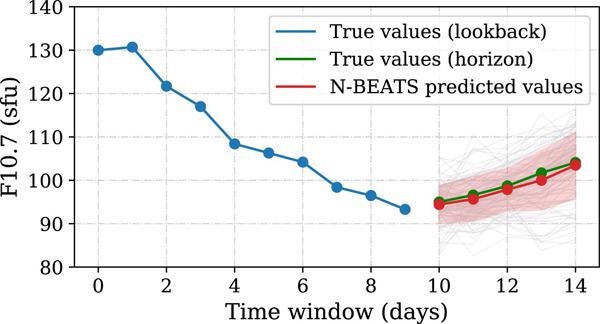A deep learning method that had formerly demonstrated favorable performance in forecasting problems was used by scientists from the Department of Computer Systems Engineering at Universidad Politécnica de Madrid, in partnership with the University of Strathclyde (UK), to predict the F10.7 solar radio flux over days-ahead timescales pertinent to space operations.
 An example of a 5-day forecast of the F10.7 generated by N-BEATS. (Image Credit: Universidad Politécnica de Madrid).
An example of a 5-day forecast of the F10.7 generated by N-BEATS. (Image Credit: Universidad Politécnica de Madrid).
The F10.7 index, which is a measurement of the strength of solar radio emissions with a wavelength of 10.7 cm, is used as a substitute for solar activity, a key driver in deviations in the density of the atmosphere, and consequently atmospheric drag.
As atmospheric drag is one of the most noticeable sources of variability in the orbit prediction of the satellites in the Low Earth Orbit (LEO), the exact modeling of this index is of great significance to help estimate the positions of space debris and satellites, and guarantee no collisions take place.
The approach used for the development of this model is based on the application of Deep Learning techniques, more precisely, using a new method based on Deep Residual Networks. This technique, based on the neural network architecture “N-BEATS” was established to be effective in single-point forecasting up to 27-days ahead, as well as able to estimate the uncertainty in the forecast using a collection of models.
The researchers discovered that the N-BEATS model outclassed two forecast tools currently used by space operators: one statistical (provided by BGS, ESA) and one multi-flux shallow neural network (by CLS, CNES).
With an increasing number of private companies providing services in space, the results of this study are crucial for the space sector, as they can be used to create tools to predict the drag conditions soon and render more precise orbit predictions.
Journal Reference:
Stevenson, E., et al. (2021) A Deep Learning Approach to Solar Radio Flux Forecasting. Acta Astronautica. doi.org/10.1016/j.actaastro.2021.08.004.